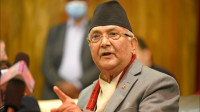National
Inflation fears as banks report large withdrawals ahead of local elections
Central bank expects currency in circulation to rise by Rs10-15 billion during the elections.
Prithvi Man Shrestha
In the last two weeks, the NMB Bank has witnessed increased cash withdrawals from saving accounts, in the manner usually seen ahead of major festivals.
“We assume it’s because of the elections,” said Sunil KC, chief executive officer of the NMB Bank. “Such withdrawals otherwise usually take place during festivals like Dashain and Tihar.”
Local elections are scheduled for May 13 in a single phase across the country. The Election Commission has set Tuesday midnight as the deadline for parties and candidates to run their campaigns before the start of the silence period.
Campaigns need money.
Observers say elections are like festivals when huge amounts of cash flow into the market. And during the election season, the market actually sees more cash than during festivals, as money from outside the banking system also comes out.
The general perception is that the more money is unleashed into the market, the more vibrant the economy becomes. But there are downsides too—it may increase inflation and put pressure on the liquidity situation of the banks and financial institutions.
“During elections, demands for consumer goods, including food items, surge because of poll campaigns which push their prices up,” said Keshav Acharya, an economist.
Inflation in Nepal is already on an ascending order because of rising prices of food, energy and the metal due to the war in Ukraine. In mid-March, Nepal’s consumer inflation reached a 67-month high at 7.14 percent.
The World Bank in its publication ‘Nepal Development Update’ stated last month that though the direct impact of higher global fuel and edible oil prices on consumer inflation is expected to be low given that the share of these products is only around five percent of the consumer expenditure, higher inflation is likely in Nepal from indirect effects such as increase in the prices of transportation and other food and non-food items.
“And election spending is fuelling the fire amid an already high inflationary pressure,” said Acharya.
Nepali parties’ campaign spending has already been on an upward trend.
The Election Commission has set spending limits at Rs750,000 for candidates contesting for chiefs and deputy chiefs of metropolitan cities, Rs550,000 for those contesting for the same positions at sub-metropolises, 450,000 for municipalities, and Rs350,000 for rural municipalities.
Candidates for other posts can spend a maximum of Rs300,000 at metropolitan cities, Rs250,000 at sub-metropolitan cities, Rs200,000 at municipalities and Rs150,000 at rural municipalities, according to the commission.
It, however, has become apparent from various reports and studies that candidates spend way more than the limit set by the election body.
A study conducted by the Election Observation Committee Nepal, a poll observation body, found a mayoral candidate’s average spending during the local elections in 2017 amounted to Rs1.73 million while a deputy mayor hopeful spent an average of Rs1.38 million.
With the candidates needing to spend more money for poll campaigns and the government needing to mobilise its employees for the polls, cash withdrawal increases during the elections, according to officials at the central bank.
Revati Prasad Nepal, executive director heading the currency management department at the central bank, told the Post that currency in circulation in the market increased by around Rs4 billion in the last 10 days.
Currency in circulation refers to the amount of cash—in the form of paper notes or coins—within a country that is physically used to conduct transactions between consumers and businesses.
“Currency in circulation went up to around Rs647 billion now from Rs643 billion 10 days ago,” said Nepal. The week before, currency in circulation had remained in the range of Rs643-Rs644 billion.”
According to Nepal, the central bank expects the currency in circulation to rise by Rs10-Rs15 billion due to increased cash withdrawals.
“The rise in currency in circulation means more cash in the hands of people. It leads to an increase in the demand for goods and services, leading to higher inflation,” said Nepal.
The country’s banks and financial institutions are already under pressure, facing shortage of loanable funds. And there are concerns that increased withdrawals could affect the liquidity situation.
Kiran Kumar Shrestha, chief executive officer of Rastriya Banijya Bank, said his bank has not yet witnessed substantial rise in withdrawals. “Maybe withdrawals are high in other banks. General public withdrawing the cash on a large scale will of course affect the liquidity of the banks,” he said.
The existing credit-to-deposit ratio of the banks and financial institutions also suggest tighter liquidity in the banking system.
Credit-to-deposit ratio of banks and financial institutions is currently over 90 percent. Though they are supposed to maintain the credit-to-deposit ratio below 90 percent, Nepal Rastra Bank has allowed them to lower it to 90 percent by the end of the current fiscal year ending mid-July considering the need for credit expansion to boost economic activities in the early months of the current fiscal year.
Credit-to-deposit ratio crossing the regulatory threshold means the banking sector is not capable of lending further.
Cash withdrawals from the banking system have gone up when the capital expenditure of the government has been disappointing at just over 30 percent as of Monday, according to the Financial Comptroller General Office.
“We will ensure that the rise in currency circulation remains within our estimate range,” said Nepal. “We will intervene if the circulation exceeds the range.”




 5.4°C Kathmandu
5.4°C Kathmandu










%20(1).jpg&w=300&height=200)



